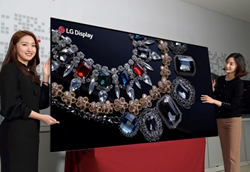Leigh Stark* says that 4K television which the guy in the shop said was the ultra in Ultra HD is about to become ‘soooo 2017’.
 My TV is mocking me.
My TV is mocking me.
It stares at me with a blank face, waiting for me to turn it on.
It wants to show me what amazingly glorious pictures of the world await through its eyes.
However, it knows the cold, hard truth: It will never be as amazing as what’s coming next.
Yours is mocking you too, for it will never have the panache and appeal of the next big thing, which is closer than we could all expect.
In TV land, the end of September will be when everything we all own is truly out of date, and you’ll have something shiny and new to spend money on.
Factor in the cost of a new iPhone or three, and September is shaping up to be very, very expensive.
By the end of September, those with more money than they know what to do with will be able to feast their eyes on TVs that have more pixels than they respectively know what to do with.
8K becomes a reality.
4K is barely five years old, and if you grabbed a new TV because you were told by the guy in the shop that 4K was the “ultra” in Ultra HD, you’re about to see something else, because 8K is Ultra HD, too.
Only it’s more ultra. Hyper-ultra.
Four times the “ultra”, with 33 million pixels in 8K compared with the measly eight million in 4K.
In short, 4K is no longer the bee’s knees. More like the bee’s other less important appendages.
It’s the bee’s ankles; necessary, but who really cares?
Now all focus is on 8K, and in Australia, Samsung will have these TVs first, offering its quantum dot LED-backlit TVs known as QLED in four sizes of the Q900R, ranging from 65 to 85 inches.
It will even come with a degree of artificial intelligence, though not the kind science fiction tells us to be scared of.
Rather, it’s one that can help 8K complete the picture… literally.
Remember how long it took for movie and technology companies to come together and get 4K video to those new TVs?
If you were first in line for a 4K Ultra HD screen, you probably spent a good year or two telling your friends how amazing this screen was going to be.
Then Netflix finally offered 4K streams and Apple brought out its 4K Apple TV, and suddenly you were vindicated.
It took some time, but you got there.
Well, the same is true for 8K.
No content, no media, and if you want to throw your photos on the screen, you need to be using a super expensive camera capable of capturing in 33 megapixels or higher.
Upscaling is the way forward, at least for the moment, and artificial intelligence might be the thing that gets it there.
Samsung’s 8K TVs rely on the colour honing quantum dot crystals (that’s what the “Q” means), as well as that neat ambient wallpaper mode we saw on this year’s TVs.
The price is, as of yet, unknown.
Expect big, and expect to be the first on your street with one, possibly the first in the country with 8K.
8K Ultra HD won’t be a Samsung-only affair either, though you may have to wait a little bit to see what everyone else is offering.
TCL has a minimalist 8K set in its X10 we’re not expected to see until next year, while LG has the world’s first 8K OLED TV.
This means all 33 million pixels can turn on and off as and when they’re needed, potentially making it the most contrast-laden TV on the planet.
LG’s 8K OLED TV will come in 88 inches only, and from the looks of things, it will be a part of LG’s ‘signature’ range, again matching the more-money-than-sense side of life.
If you want the best, that’s likely where you’ll find it, but probably not until next year.
It will definitely be the biggest and best OLED TV out there, so there’s that, but you have to wait for it.
As for what you can do with your old 4K TV, we can think of numerous things, though watching it may not be quite as satisfying as it used to be, not when there’s a delicious 8K sitting nearby.
The responsible thing would be to just throw it out, or give it to someone you want bragging rights over.
Or just give it to the kids; they’ll never know the difference, anyway.
*Leigh Stark is a Sydney-based writer, journalist and photographer who contributes to the Australian Financial Review. She tweets @Leighlo
The article first appeared at www.afr.com.


